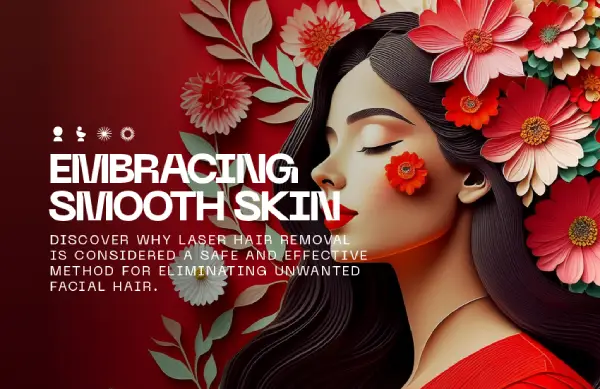Blog
Is laser hair removal safe for facial hair?

Contents
Understanding laser hair removal
Facial laser hair removal: What you need to know
Is facial laser hair removal safe?
Effectiveness of laser hair removal on facial hair
Ideal candidates for facial laser hair removal
Preparing for facial laser hair removal
Aftercare and recovery
Alternative facial hair removal methods
Say goodbye to facial fuzz
Laser hair removal is a popular pick for people seeking a smooth, hair-free appearance.
This procedure stands out from traditional hair removal options, like shaving, waxing, and threading, as it delivers long-term results. While it’s generally considered safe, you may have some specific concerns about laser hair removal on a delicate body part like the face.
In this guide, we explore the safety aspects of facial laser hair removal and provide important factors to consider.
Understanding laser hair removal
Laser hair removal is a widely recognized aesthetic procedure that uses concentrated beams of light to remove unwanted hair.
During the process, a laser device emits light energy, which is then absorbed by the melanin in the hair follicles. The energy converts into heat, impacting the hair follicles and preventing new growth.
Your hair grows in cycles, and not all the follicles are in the same phase at the same time. Laser hair removal is most effective when done in a series of sessions spaced several weeks apart, as this targets hair in varying growth stages.
Laser hair removal is considered a safe technique for long-term hair reduction. However, applying it on the face may require extra considerations due to differing hair textures and hormonal influences.
Results can vary between individuals with different skin and hair types. It’s important to note that this procedure offers a long-lasting reduction in hair growth rather than complete removal. Maintenance sessions could also be required.
The laser hair removal process
Here’s a brief overview of how the laser hair removal process typically works.
- Once the patient is in a comfortable position, the practitioner cleans the area to remove excess oils and dirt from the skin.
- The specialist applies a cooling gel to minimize discomfort and protect the skin from laser-generated heat. Eye protection is also provided for both the patient and practitioner.
- The therapist adjusts the laser device to the right parameters based on the patient’s skin type, hair type, and location of the treatment. They also ensure the room is free of reflecting surfaces or metallic objects.
- The practitioner places the device perpendicular to the skin. They press down, temporarily decreasing blood supply to the area and bringing the hair follicles to the surface.
- Laser pulses are emitted, prompting the melanin in the hair follicles to absorb the light energy. The resulting action impairs the hair follicles and stunts development.
You can go home immediately after the procedure and resume most of your regular activities. It’s normal to have some redness and swelling afterward, but these reactions subside within a few days.
Many people are comfortable during a laser hair removal session, but some may experience a mild sensation similar to a snapping rubber band. The cooling gel helps ease any discomfort tremendously.
Types of lasers used in the procedure
There are various types of devices used in laser hair removal, each boasting different characteristics. The choice of laser depends on the patient’s skin color, hair color, and specific concerns.
Below are the most common devices used in laser hair removal.
- Diode lasers operate at a range of around 800–810 nanometers. They’re suitable for people with light to medium skin tones and dark hair. Diode lasers offer excellent penetration and are known for their efficacy in treating large areas.
- Alexandrite lasers emit light at a wavelength of around 755 nanometers. They’re ideal for individuals with light to olive skin tones and fine to medium hair. Alexandrite lasers are popular for their speed and usefulness in treating larger areas.
- Nd:YAG lasers run at wavelengths of around 1,064 nanometers. They’re versatile and suitable for a wide range of skin types, including those with darker tones. Nd:YAG lasers offer deeper penetration, making them a brilliant option for coarse, dark hair.
- Ruby lasers have a wavelength of 694 nanometers. They’re less popular due to their limitations in treating people with darker skin tones. They’re only suitable for individuals with fair skin and dark hair.
At LIVV Natural, we use DiolazeXL in our laser hair removal treatments. This device offers peak power, speed, quick results, and targets a larger surface area.
Facial laser hair removal: What you need to know
The skin on your face is more sensitive than the skin in other areas, so there are some considerations to keep in mind.
It’s vital to use the right laser, as the wrong one could lead to skin irritation, excess redness, or burns. People with darker skin tones are at an elevated risk of hyperpigmentation and changes in skin color if the incorrect device is used.
Exposure to the sun before and after laser hair removal can result in complications, so it’s important to stay out of its rays. Since your face sees the sun almost daily, it can be more of a mission to keep yourself covered. Use sunscreen, hats, sunglasses to stay protected.
Is facial laser hair removal safe?
Facial laser hair removal is a safe aesthetic procedure when performed professionally. The risk of adverse side effects drastically lowers when you choose a qualified practitioner. They have the necessary training and skills to perform facial laser hair removal safely and effectively.
Professional therapists understand individual nuances, how to use the equipment correctly, and how to manage potential challenges. They also adhere to strict ethical standards and safety protocols, which are crucial when working on a sensitive area like the face.
Safety considerations
Below are some important safety considerations for facial laser hair removal.
- Fitzpatrick skin type: The practitioner must adjust the laser to the patient’s skin type to minimize the risk of complications. A qualified professional can determine your Fitzpatrick skin type and tailor the treatment accordingly.
- Hair and skin color: A person with dark hair and light skin is the best candidate for treatment. Those with dark skin tones or light hair often require specialized lasers.
- Medical history: Certain conditions and medications can affect the safety of laser hair removal. It’s vital to conduct a thorough assessment to identify potential contraindications.
Possible side effects and risks
Here are some potential side effects and risks to facial laser hair removal, along with ways to manage them.
- Pain and discomfort: Facial laser hair removal can be more painful than other body areas. Your practitioner should use a cooling device or numbing cream to keep you comfortable.
- Temporary side effects: Most people experience redness and swelling after the procedure, but it only lasts a few days. Apply a cool compress to ease discomfort.
- Eye protection: Proper protection is vital during facial laser hair removal to prevent eye damage. Both you and the practitioner should wear protective goggles or shields.
- Hyperpigmentation and hypopigmentation: Changes in skin pigmentation are a potential risk, especially for those with darker skin tones. A qualified practitioner knows which laser settings are appropriate to use.
- Blisters or burns: Inexperienced therapists could accidentally cause burns or blisters, but a knowledgeable professional understands the importance of precise laser settings and proper cooling measures.
Effectiveness of laser hair removal on facial hair
Laser hair removal can effectively reduce the amount of hair on your face, but the success rate depends on numerous factors.
- Hair color and skin type: People with dark hair and light skin respond best to laser treatment. Those with lighter hair colors, like blonde, red, or gray, may not achieve optimal results due to a lack of pigment in the hair follicle.
- Professional expertise: The skin on your face is sensitive, and successful laser hair removal requires a skilled practitioner that can ensure safety and efficacy from a customized treatment plan.
- Hair growth cycles: Laser hair removal is most effective during the anagen phase of hair follicle growth. Since not all hair follicles enter this stage simultaneously, multiple sessions are generally needed.
- Hormonal factors: Hormonal changes due to pregnancy or conditions like polycystic ovary syndrome (PCOS) can impact facial hair growth. Patients may require ongoing maintenance sessions to manage regrowth.
- Patient compliance: It’s vital to follow your doctor’s instructions before and after treatment. Recovery may include avoiding the sun and not using certain products.
- Type of laser used: There are many types of lasers for hair removal, and their effectiveness varies. The most popular options include alexandrite, diode, and Nd:YAG lasers.
- Individual expectations: Facial laser hair removal doesn’t guarantee permanent results. Although many people enjoy a long-term reduction in hair growth, occasional touch-ups are often necessary.
Facial laser hair removal procedures generally offer positive results. Suitable patients can expect a significant reduction in facial hair growth along with smoother-looking skin.
Each individual will have a different timeline of results. Most people need 6–8 sessions spaced across several weeks to ensure that all hair follicles are effectively treated at each growth phase.
Ideal candidates for facial laser hair removal
The Fitzpatrick skin type scale classifies individuals into different categories based on their reaction to sun exposure. Facial laser hair removal is more effective for people with light skin and dark hair. These individuals typically have an I, II, III, or IV skin type classification.
Since the treatment targets the melanin in the hair, the contrast helps the laser “see” the follicles better. Those who tan easily or have a darker skin tone require specialized lasers to avoid pigmentation problems.
Individuals with light or fine facial hair (commonly called “peach fuzz”) may have a harder time seeing results, as there’s not enough melanin for the laser to target. Emerging technologies, like diode lasers, may be the answer for light-haired patients.
People with the following conditions may require further assessment before undergoing facial laser hair removal.
- Pregnancy
- PCOS
- Eczema
- Psoriasis
- Dermatitis
- Use of photosensitizing medications
- Use of topical treatments like retinoids and glycolic acid
- Keloid scarring
- Recent facial cosmetic procedures
- Active infections or cold sores
- Skin cancer
Preparing for facial laser hair removal
The first step in facial laser hair removal is to book a consultation with a qualified practitioner. They’ll determine if you’re a suitable candidate by assessing your skin type, hair color, and medical history.
Once you get the green light, your doctor will give you instructions to follow prior to your procedure. Below are some common preparations you’ll need to make.
- Avoid plucking or waxing for six weeks prior to the procedure.
- Shave the area a few days before the session to allow some stubble to form and provide a target for the laser.
- Use a broad-spectrum sunscreen with high SPF and minimize sun exposure.
- Refrain from artificial tanning methods.
- Stop using skincare products that contain retinol, glycolic acid, or other exfoliating agents at least a week before the procedure.
Aftercare and recovery
Expect to have some redness and swelling immediately after your facial laser hair removal session. Apply a cool compress to ease any discomfort. In rare cases, your doctor can prescribe a topical steroid cream if the symptoms worsen.
Prevent possible side effects by following a strict sun protection routine. Stay out of direct light, steer clear of tanning equipment, use a hat, and apply sunscreen regularly. Wash your face with a mild cleanser and apply a gentle, fragrance-free moisturizer. Avoid hot water.
An initial treatment plan often consists of 4–6 sessions spaced 4–6 weeks apart. Patients may need to do a maintenance treatment every 6–12 months to eliminate any peach fuzz that grows back.
Alternative facial hair removal methods
There are many ways to remove unwanted facial hair. Let’s explore some popular alternatives to laser below.
- Shaving is a quick and easy method that involves the use of a razor. It doesn’t target the hair follicles, so regrowth occurs rapidly, often resulting in coarser hairs.
- Waxing involves applying hot or cold wax to facial hair and quickly removing it. While it provides longer-lasting results than shaving, it’s a temporary solution and may cause irritation for those with sensitive skin.
- Depilatory creams contain chemicals that break down the hair’s structure, allowing it to be wiped away. They provide temporary removal but may cause allergic reactions in some individuals. Regrowth is relatively quick.
- Threading is an ancient hair removal technique that uses a twisted thread to remove hair at the follicle level. It’s suitable for shaping eyebrows and removing fine facial hair, but is temporary and may cause slight discomfort.
- Intense pulsed light (IPL): Similar to laser hair removal, IPL uses broad-spectrum light to target hair follicles. These techniques share some characteristics, but IPL is less targeted and may require additional sessions for comparable results. Many consider laser technology superior.
- At-home laser devices are convenient, but they’re not as powerful or precise as a professional treatment. Professional laser hair removal is generally safer and more effective.
Say goodbye to facial fuzz
The choice of facial hair removal depends on individual preferences, budget, pain tolerance, and desired results. Laser hair removal is often favored for its efficiency in long-term hair reduction.
It’s considered a safe and effective method of reducing unwanted hair. The number of required sessions varies according to individual goals, but the amount of hair on your face lowers with each treatment.
It’s important to pick a qualified and experienced practitioner. They know how to adhere to safety protocols and can provide advice based on your skin type, hair color, and medical history. It’s also crucial to follow your specialist’s instructions before and after the procedure.
Are you ready to put your best face forward? Book a consultation with our specialists at LIVV Natural to learn more about facial laser hair removal.
Author: Dr. Jason Phan NMD – Founder of LIVV Natural – Anti-aging – regenerative medicine – peptide therapy


